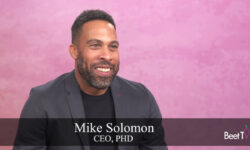SANTA MONICA, CA — AI, FAST and UX. Those are three of the acronyms Matt McLeggon thinks are moving the ad industry.
But, in this video interview with Beet.TV, McLeggon, SVP, Advanced Solutions, Magnite, warns that, to make the best of the new capabilities, the industry needs an open ecosystem to come together to tackle growing complexity.
McLeggon was speaking to Beet.TV contributor Rob Williams during the Beet Retreat Santa Monica, November 15 to 17.
Driving change
Magnite is the world’s largest independent sell-side advertising company. Publishers use Magnite’s technology to monetize their content across all screens and formats including CTV, online video, display, and audio.
McLeggon opened up on what he sees as factors driving change in the space…
1. CTV User Experience
McLeggon worries the top complaint from consumers is seeing the same ad repetitively. He believes that this is a problem of interoperability between different technology platforms, and the advertiser and media owner not effectively communicating with each other. Though progress has been made, he says it remains a work in progress.
2. The Evolution of FAST
When asked about the evolution of free ad-supported TV (FAST), McLeggon is quick to point out the importance of this rapidly growing sector. “FAST is really interesting for one, because they’ve been sort of the fastest growing cohort of media owners,” he says. FAST TV operators have been pioneers in the ecosystem, unencumbered by legacy businesses, and have moved swiftly into programmatic and automation.
3. The Impact of AI
You can’t attend a business conference these days without discussing artificial intelligence. But what is AI’s impact on the TV advertising space? “Hard to overstate,” McLeggon says. While it doesn’t use generative AI, Magnite leans heavily on machine learning. One area where AI has proven highly beneficial is content review. “We used to have an offshore team that would literally sit there and review every piece of ad creative before it ran… but (now) we also have a computer that can do it, right?” he shares.
The Interoperability Imperative
Overall, though, McLeggon is concerned that the ad-tech ecosystem is too fragmented to combat what he sees as the negative impacts of big platforms like Google and Meta.
“CTV is more capable (than linear), but there’s a lot more complexity as well,” he says. The main challenge lies in the difference between linear television measurement and streaming TV measurement – McLeggon says it is critical that platforms can easily prove to marketers the effectiveness of their spend.
While there is certainly an open ecosystem of sorts – a collection of companies that have grown up, partnered and integrated their respective tech stacks to in an attempt to approximate the might of their rivals – that has grown up in recent years.
But Magnite’s McLeggon believes this ecosystem needs to work better together. “There’s a tension between partnership and innovation,” he says. “There are trade-offs to be had between bringing a differentiated solution to market and creating standards. And those are the kind of things we have to work through in order to compete with the big guys.”














































